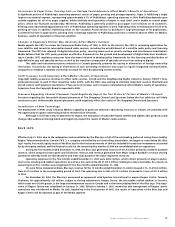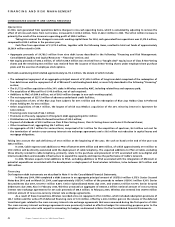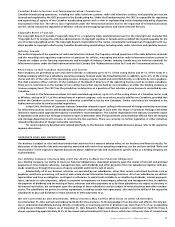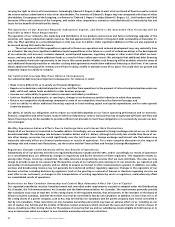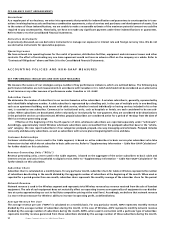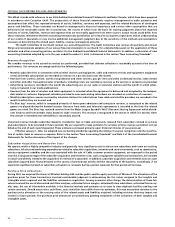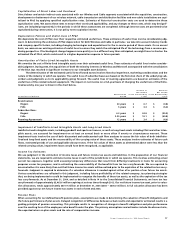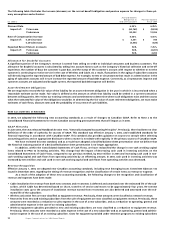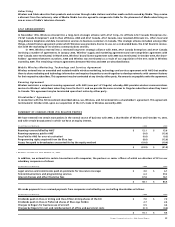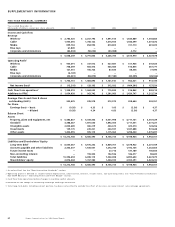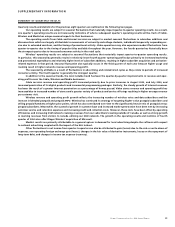Rogers 2004 Annual Report Download - page 57
Download and view the complete annual report
Please find page 57 of the 2004 Rogers annual report below. You can navigate through the pages in the report by either clicking on the pages listed below, or by using the keyword search tool below to find specific information within the annual report.
55
Rogers Communications Inc. 2004 Annual Report
When used or reported for a period greater than one month, ARPU represents the monthly average of the ARPU calculations for the
period. We believe ARPU helps indicate whether we have been successful in attracting and retaining higher usage subscribers. Refer to
the “Supplementary Information – Average Revenue Per User” section for further details on this Wireless and Cable calculation.
Operating Expenses
Operating expenses are segregated into three categories for assessing business performance:
• Cost of sales, which is comprised of wireless equipment costs, Video Stores merchandise and depreciation of Video Store rental
assets, as well as cost of goods sold by The Shopping Channel;
• Sales and marketing expenses, which represent the costs to acquire new subscribers (other than those related to equipment), such as
advertising, commissions paid to third parties for new activations, remuneration and benefits to sales and marketing employees, as
well as direct overheads related to these activities and the costs of operating the Video Store locations and the retail operations of
Wireless stores; and
• Operating, general and administrative expenses, which include all other expenses incurred to operate the business on a day-to-day
basis and service existing subscriber relationships, including retention costs, inter-carrier payments to roaming partners and long-
distance carriers, programming related costs, the CRTC contribution levy, Internet and e-mail services and printing and production costs.
In the wireless and cable industries in Canada, the demand for services continues to grow and the variable costs, such as commissions
paid for subscriber activations, as well as the fixed costs of acquiring new subscribers are significant. Fluctuations in the number of acti-
vations of new subscribers from period to period and the seasonal nature of both Cable and Wireless subscriber additions result in
fluctuations in sales and marketing expenses and accordingly, in the overall level of operating expenses. In our Media business, sales
and marketing expenses may be significant to promote publishing, radio and television properties, which in turn attract advertisers,
viewers, listeners and readers.
Cost of Acquisition Per Subscriber
Cost of acquisition per subscriber (“COA”), which is also often referred to in the industry as “subscriber acquisition cost” or “cost per
gross addition”, is calculated by dividing total sales and marketing expenditures, plus costs related to equipment provided to new sub-
scribers for the period, by the total number of gross subscriber activations during the period. COA is a measure used most commonly in
a Wireless context and varies depending on the level of the subscriber’s monthly revenue and term of a subscriber’s contract. Total
gross subscriber activations include postpaid and prepaid voice and data activations and one-way messaging activations. Refer to
“Supplementary Information – Cost of Acquisition per Gross Addition” for further details on this Wireless calculation.
Operating Expense Per Subscriber
Operating expense per subscriber, expressed as a monthly average, is calculated by dividing total operating, general and administrative
expenses, plus costs related to equipment provided to existing subscribers, by the average number of subscribers during the period.
Operating expense per subscriber is tracked by Wireless as a measure of our ability to leverage our operating cost structure across a
growing subscriber base, and we believe that it is an important measure of our ability to achieve the benefits of scale as we increase
the size of our business. Refer to “Supplementary Information – Operating Expense per Average Subscriber” for further details on this
Wireless calculation.
Operating Profit and Operating Profit Margin
We define operating profit as net income before depreciation and amortization, interest expense, income taxes and non-operating
items, which include foreign exchange gains (losses), loss on repayment of long-term debt, change in fair value of derivative instru-
ments, non-controlling interest, gain of sale of investments, writedown of investments, income (loss) from investments accounted for
by the equity method and investment and other income. Operating profit is a standard measure used in the communications industry
to assist in understanding and comparing operating results and is often referred to by our peers and competitors as EBITDA (earnings
before interest, taxes, depreciation and amortization) or OIBDA (operating income before depreciation and amortization). We believe
this is an important measure as it allows us to assess our ongoing businesses without the impact of depreciation or amortization
expenses as well as non-operating factors. It is intended to indicate our ability to incur or service debt, invest in PP&E and allows us to
compare our business to our peers and competitors who may have different capital or organizational structures. This measure is not a
defined term under Canadian GAAP or U.S. GAAP.
We calculate operating profit margin by dividing operating profit by total revenue, except in the case of Wireless. For Wireless,
operating profit margin is calculated by dividing operating profit by network revenue. Network revenue is used in the calculation,
instead of total revenue, because network revenue better reflects Wireless’ core business activity of providing wireless services. This
measure is not a defined term under Canadian GAAP or U.S. GAAP. Refer to “Supplementary Information – Operating Profit Margin
Calculation” for further details on this Wireless, Cable and Media calculation.
Additions to PP&E
Additions to PP&E include those costs associated with acquiring and placing our PP&E into service. Because the communications business
requires extensive and continual investment in equipment, including investment in new technologies and expansion of geographical
reach and capacity, additions to PP&E are significant and management focuses continually on the planning, funding and management
of these expenditures. We focus on managing additions to PP&E because additions to PP&E have a direct impact on our cash flow.
The additions to PP&E before related changes to non-cash working capital represent PP&E that we actually took title to in the
period. Accordingly, for purposes of comparing our PP&E outlays, we believe that additions to PP&E before related changes to non-cash
working capital best reflect our cost of PP&E in a period, and provides a more accurate determination for period-to-period comparisons.


